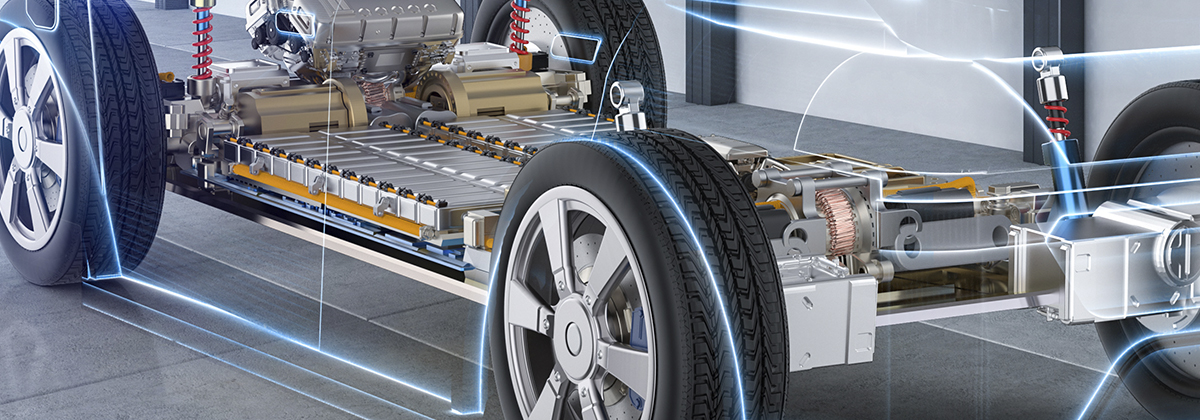Selecting an EV Battery Test System That Will Last Through Rapid Changes in Battery Technologies
July 30, 2024 | Topics: Battery Test, EV Battery
The EV industry is still in its infancy. Overcoming the challenges of achieving long driving distances and fast charging are essential for mass market acceptance. Battery and EV manufacturers are investigating new battery technologies to overcome these two major challenges. Without knowing the winning technologies, how do you specify a test system that meets today’s needs and covers unknown future needs and growing demand? Here is an overview of the state of battery technology and the requirements to consider when selecting a battery test system.
State of EV battery technology
Lithium-ion technology is the primary technology today for EV batteries. While lithium-ion batteries have the highest energy density in production today, they have the tradeoff of susceptibility to overheating and thermal runaway. Newer battery chemistries and design types promise higher efficiency, lighter weight, faster charging and less risk of overheating. However, all the contestants need more research and development time to make them potential successors to Lithium-Ion batteries.
- Lithium-sulfur batteries are starting to be considered as they eliminate the need for the costly cobalt in a lithium battery. However, the current limitation of lithium-sulfur batteries is their low lifetime.
- Graphene-based batteries are also grabbing attention. Graphene dissipates heat more efficiently than Lithium-Ion batteries and becomes a much lighter battery. Graphene batteries can recharge faster and can hold more energy. Currently, manufacturing a battery based on graphene is expensive and difficult to scale.
- Zinc-air batteries can store much energy relative to their weight, and zinc is abundant and inexpensive. Yet, the power density is low, zinc-air batteries have shorter lifespans, and recharging issues exist.
- Solid-state batteries are a promising technology. The technology offers an extensive lifespan, quick charging capabilities, less risk of thermal runaway, and low maintenance requirements. The benefits are promising, and proponents say solid-state batteries will be on the market in a few years.
How quickly are new innovations coming? No matter the materials, the goal is always more power, more speed and more distance.
 The bragging rights belong to who has the longest range and the fastest charging.
The bragging rights belong to who has the longest range and the fastest charging.
Selecting the programmable power supplies for today’s and tomorrow’s EV battery testing
Challenge: Increasing EV battery pack voltage
EV manufacturers, desiring to maximize driving range, are looking for methods to minimize vehicle weight. One method is to increase battery voltage, which enables smaller, lighter cables. Manufacturers are transitioning to 800 V batteries from 400 V batteries. Most likely, battery pack voltages will get even higher for other vehicles, such as trucks, trains, and even airplanes. When selecting test equipment that will last through the next few generations, how high a voltage should you plan for?
Solution: Test instrumentation manufacturers like EA Elektro-Automatik are starting to respond to this question with more flexible, modular test solutions. One example is the EA-BTS 10300 Battery Cycler and Test System with a voltage rating of 1500 V. If you think you might even need a higher test voltage, the system has an option to increase the voltage rating to 2000 V. That should cover you now and for the next ten years of EV battery innovation.
Challenge: Higher capacity battery packs
Increasing battery pack kWh capacity also increases range. Yet many EV battery manufacturers face limitations when testing newer, high-power batteries. How can you avoid having insufficient programmable DC power supplies to test a new battery pack?
Solution: No matter what you select now, the modularity of a system such as EA-BTS 10300 allows you, as the test engineer, to start with one test rack, which provides 30 – 300 kW. You can then add as many as 13 test racks with 300 kW capacity to have a system with as much as 3.84 MW capacity.
You may not need as much power in an individual instrument as your calculations indicate. The bidirectional power supplies used in the EA-BTS 10300 have a true autoranging output (or input) characteristic. They have a wider current range and can deliver or sink full power to 1/3 of the voltage rating. You would need three times the power to provide the same current output with a conventional power supply with an equivalent voltage rating. See Figure 1, which compares the output of an EA power supply with the rectangular output of a conventional power supply.
 Figure 1. Autoranging instrument compared with an equivalently powered instrument (left) and with an instrument with 3 times the power (right)
Figure 1. Autoranging instrument compared with an equivalently powered instrument (left) and with an instrument with 3 times the power (right)
Challenge: Adapting to limited factory floor space
As with any manufacturing operation, floor space for test equipment is always at a premium. So, aside from power capacity, you’ll need to ensure that you have the available floor space even for that 3.84 MW system.
Solution: Power density is a critical question to consider when specing your next battery test system. EA Elektro-Automatik has built its power supply technology on SiC power transistor technology, which is why its test systems produce the highest power density on the market. This allows a rack with 300 kW to consume only 6.5 sq ft of floor space. The space savings can be even greater if the total power required exceeds 300 kW.
Challenge: Fast data acquisition
To capture intermittent problems, a test system must have high resolution and fast data acquisition. Acquiring data at a high rate allows test engineers to see more information and to detect battery pack defects easily.
Solution: The EA-BTS 10300 monitors battery voltage and current with 16-bit, 1.5 kHz measurement electronics. A system option increases resolution to 24 bits. The EA-BTS 10300 has the fastest data acquisition rate among competitive test systems.
Challenge: Adaptable software
As EV battery testing requirements change with new battery technologies, the more flexible the software is, the better.
Solution: Software setup can be among the most time-consuming aspects of building any new test system, particularly when trying to integrate multiple test software tools into a single, integrated solution. While other battery test systems require multiple software packages, the EA-BTS 10300 includes a single package for battery testing. The EA software allows test definition, parameter setup, test sequencing and data file creation. In addition, the software includes drive cycle simulations and allows a user-defined display. A widget-based programming structure without coding creates the required performance to adapt to a new battery type and capacity.
Challenge: System and battery protection
No matter what EV battery technology you are testing, you want to ensure both your batteries-under-test and your test system are protected from harmful damage. Monitoring battery temperature is essential. Furthermore, your test system should check for reverse polarity connections to the battery packs and determine if a pre-charge is required. Your system should avoid connecting to the battery unless the system voltage and voltage are matched to avoid transferring a damaging power level to either the battery pack or the test system. Another important test is an insulation resistance measurement, which indicates potential shorts in the battery pack.
The EA-BTS 10300 monitors these conditions to protect battery packs and the test system, and the bidirectional power supplies in the test system have overtemperature, overcurrent, overvoltage, and overpower protection monitoring to protect the test system instrumentation from a damaging failure.
Challenge: Saving energy
Using resistor loads or conventional electronic loads converts absorbed energy into heat. With high-power EV batteries, a large amount of test system energy is required. The lost energy can be recovered if regenerative loads or regenerative bidirectional power supplies are used to absorb battery energy.
With the highest regenerative efficiency in the industry at 96.5%, the EA-BTS 10300 can save a significant amount of utility costs and reduce infrastructure costs required to remove all the generated heat. Compared with using a passive resistive load, one manufacturer was able to save $20,000 a month in utility costs when switching to EA-BTS 10300 systems. Using regenerative bidirectional programmable power instrumentation can justify a battery test system based on a return-on-investment analysis.
 EA Elektro-Automatik bidirectional power supplies have the highest regenerative efficiency of 96.5%.
EA Elektro-Automatik bidirectional power supplies have the highest regenerative efficiency of 96.5%.
Challenge: Ensuring maximum uptime
The requirements to meet growing demand targets emphasize the importance of keeping your system up and running. A modular system can help to overcome this challenge. Easy replacement of components can keep a system downtime short.
The EA-BTS 10300 uses standard off-the-shelf bidirectional power supplies that are isolated from each other with independent external fuses. Replacing a power unit takes a system out of service for no more than ½ hour. Then, the system can be up, and the batteries can be tested again.
Challenge: Build vs buy
Building a system appears to yield significant cost savings compared with the price of a turnkey test system. That, most likely, is due to the many costs that are not easily quantified. The highest cost could be the lost opportunity costs on essential company projects that are delayed or canceled. Purchasing resources must involve spending time obtaining products of higher cost and low volume that are not customarily procured. Labor, which may have little experience with system assembly, must build and test the system. Software must either be developed or purchased. Of most importance, the system requires documentation so it can be supported. Consider these costs in your analysis.
Turnkey systems avoid the consumption of critical resources that delay new product introductions. The systems contain battery test expertise and quality designs that are compliant with international safety standards. Furthermore, the programmable power systems come with thorough documentation and in-warranty and lifetime support.
Turnkey battery test systems, such as the EA BTS-10300 system configurations shown in Figures 2 and 3, can be cost-effective for high-volume EV battery testing. Furthermore, the EA-BTS 10300 can easily adapt to different battery types, as well as higher voltage and higher capacity batteries. The EA-BTS 10300 meets the requirements for existing EV battery packs and can adapt and grow to meet future needs.
 Figure 2. EA-BTS 10300 system with 300 kW capacity and showing interfaces to the battery packs and an environmental chamber
Figure 2. EA-BTS 10300 system with 300 kW capacity and showing interfaces to the battery packs and an environmental chamber
 Figure 3. 4-rack EA-BTS10300 system with 1.2 MW capacity and separate power control (PCC) rack
Figure 3. 4-rack EA-BTS10300 system with 1.2 MW capacity and separate power control (PCC) rack
Learn more about the EA-BTS turnkey Battery Cycler and Test System here or contact us at sales@elektroautomatik.com. To schedule an in-person or online demonstration with any EA applications engineers, visit our Demo Page.

